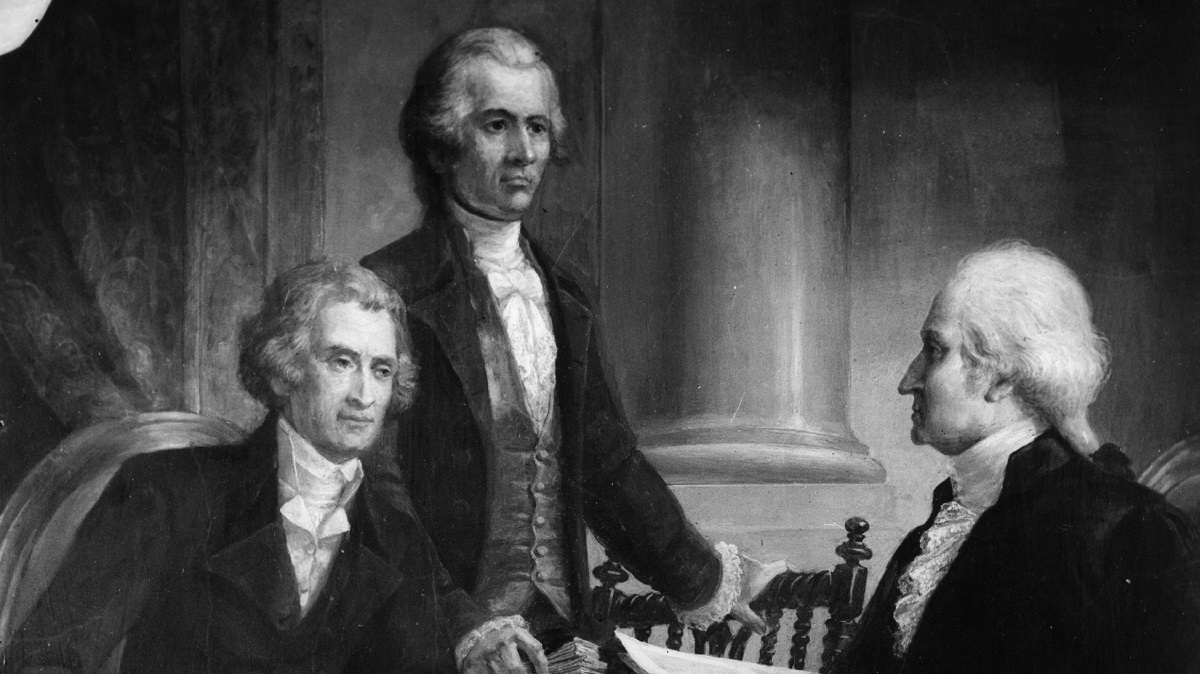Introduction
The Federalist Party, led by prominent figures such as Alexander Hamilton and John Adams, played a crucial role in shaping the early political landscape of the United States. Alongside their positions on issues like federal power and foreign policy, the Federalists also held distinctive views on banking and its role in the nation’s economic development.
During the formative years of the United States, the concept of banking was still relatively new and controversial. The Articles of Confederation, the first governing document of the newly independent nation, did not provide for the establishment of a central bank. However, as the challenges of managing the country’s finances and promoting economic growth became apparent, debates arose regarding the necessity and structure of a national banking system.
The Federalists believed that a well-regulated banking system was essential for fostering economic stability and facilitating commerce. They saw a national bank as a means of achieving these goals, with the potential to provide a stable currency, facilitate commercial credit, and support the growth of domestic industries.
This article will delve into the Federalists’ beliefs about banking and their significant contributions to the establishment of the first two national banks in the United States. Additionally, it will explore the opposition they faced and their advocacy for a centralized banking system.
The Role of Banking in Federalist Economic Policy
Banking played a crucial role in the economic policy of the Federalists. They believed that a strong banking system was essential for promoting economic growth, encouraging investment, and stabilizing the nation’s finances. The Federalists recognized the importance of providing a stable currency and ensuring the availability of credit for businesses and individuals.
One of the key goals of the Federalists’ economic policy was to build a strong and prosperous nation. They believed that a well-regulated banking system would help achieve this by facilitating commerce and supporting the growth of domestic industries. They saw banks as important intermediaries in the financial system, providing the necessary infrastructure for the smooth functioning of the economy. By providing loans and credit, banks could fuel economic expansion and entrepreneurship.
Furthermore, the Federalists recognized that a stable currency was vital for economic stability and international trade. They understood that a fluctuating or unreliable currency could hinder economic growth and create uncertainty. Therefore, they saw the establishment of a national bank as a way to stabilize the currency and provide a trustworthy medium of exchange. By creating a reliable banking system, the Federalists aimed to foster public confidence in the nation’s financial institutions.
Additionally, the Federalists believed that a strong banking sector would attract investment, both domestic and foreign. They saw banks as facilitators of capital formation, allowing individuals and businesses to accumulate and invest savings. This, in turn, would stimulate economic growth by providing the necessary funds for infrastructure development, industrial expansion, and entrepreneurial ventures.
The Federalists also recognized the importance of credit availability, particularly for small businesses and farmers. They believed that banks should play a role in providing access to credit, which would enable these groups to expand their operations and contribute to the overall prosperity of the nation. By supporting the availability of credit, the Federalists aimed to create an environment that fostered entrepreneurship and economic mobility.
Federalists’ Views on a National Bank
The Federalists strongly believed in the establishment of a national bank as a cornerstone of their economic policy. They saw a national bank as crucial for ensuring economic stability, promoting commerce, and facilitating the growth of the new nation.
The Federalists argued that a national bank would provide a centralized and regulated financial institution to oversee the country’s monetary system. They believed that a national bank could issue a uniform currency, creating stability and confidence in the financial markets. This would mitigate the risks associated with decentralized state currencies and eliminate the confusion caused by varying values and exchange rates.
In addition to a stable currency, the Federalists saw a national bank as a means to facilitate commercial transactions and encourage economic growth. They believed that a central bank could provide loans and credit to businesses, allowing for the expansion of commerce and industrial development. By offering financial support and promoting a favorable business climate, the Federalists aimed to stimulate economic activity and promote national prosperity.
Furthermore, the Federalists recognized the importance of a national bank in managing the country’s public debt. They sought to establish a bank that could regulate the issuance of government securities, provide a secure repository for public funds, and efficiently handle financial transactions on behalf of the federal government. They believed that a national bank would help stabilize the nation’s finances, attract investment, and ensure the smooth functioning of the economy.
Notably, one of the most influential advocates for a national bank among the Federalists was Alexander Hamilton. As the first Secretary of the Treasury, Hamilton played a crucial role in shaping Federalist economic policies and championed the establishment of a national bank. He argued that a national bank was essential for promoting economic growth and consolidating the country’s financial resources. Hamilton’s vision and expertise in finance greatly influenced the Federalists’ views on a national bank, and his proposals laid the groundwork for the creation of the first Bank of the United States.
In summary, the Federalists strongly supported the establishment of a national bank to ensure economic stability, foster commerce, and regulate the nation’s monetary system. They believed that a centralized banking system would provide a stable currency, promote economic growth, and manage public finances effectively. Their advocacy for a national bank laid the foundation for the implementation of the first Bank of the United States.
Alexander Hamilton’s Influence on Federalist Banking Views
Alexander Hamilton, the first Secretary of the Treasury and one of the leading figures of the Federalist Party, played a significant role in shaping and influencing the Federalists’ views on banking. Hamilton’s expertise in finance and his strong advocacy for a national banking system greatly influenced the development of Federalist banking policies.
Hamilton firmly believed that a strong banking system was crucial for the economic success and stability of the young nation. He recognized the importance of a national bank in providing a stable currency, regulating the financial system, and managing the nation’s debt. Hamilton’s influence was instrumental in the creation of the first Bank of the United States in 1791.
Hamilton’s vision for a national bank was grounded in his understanding of the importance of a centralized financial institution. He believed that a national bank would enhance the credibility and stability of the country’s monetary system. Hamilton argued that a national bank could issue a uniform currency, which would alleviate the problems associated with multiple state currencies. This would ensure that the financial transactions were conducted smoothly and efficiently across different regions of the country.
Furthermore, Hamilton saw the national bank as a necessary means to manage the country’s public debt. He believed that a national bank could efficiently handle the issuance of government securities, provide a safe repository for public funds, and oversee the repayment of debts. By centralizing these functions, Hamilton aimed to establish confidence in the fiscal stability of the new nation, attracting both domestic and foreign investments.
Hamilton’s influence on Federalist banking views extended beyond his theoretical perspectives. As the Secretary of the Treasury, Hamilton implemented his vision by presenting a comprehensive plan to Congress, which included the establishment of a national bank. He skillfully articulated the benefits of a national bank, emphasizing its role in supporting economic growth, promoting commerce, and managing the nation’s finances.
The establishment of the first Bank of the United States, on Hamilton’s recommendation, solidified his influence on Federalist banking views. The bank became a central component of the Federalists’ economic policies and demonstrated Hamilton’s ability to translate his theoretical ideas into practical action. The success and effectiveness of the first Bank of the United States further cemented Hamilton’s legacy and influence on the Federalists’ approach to banking.
In summary, Alexander Hamilton’s expertise in finance and his strong advocacy for a national banking system profoundly influenced the Federalists’ views on banking. Hamilton’s vision for a centralized financial institution, his belief in a stable currency, and his understanding of the importance of managing public debt shaped the Federalists’ perspective on banking. Through his influential role as the first Secretary of the Treasury and the implementation of the first Bank of the United States, Hamilton’s impact on Federalist banking views was both theoretical and practical.
Highlights of the First Bank of the United States
The establishment of the First Bank of the United States in 1791 marked a significant milestone in the development of the American banking system. Created under the leadership of Alexander Hamilton and with the support of the Federalist Party, the bank had several notable highlights that shaped its impact on the nation’s financial landscape.
One of the key highlights of the First Bank of the United States was its role in stabilizing the nation’s currency and financial system. The bank had the authority to issue banknotes, which served as a uniform currency across the country. This helped to eliminate the confusion and inefficiencies caused by the multitude of state currencies. The establishment of a stable currency facilitated domestic trade and fostered economic growth.
Furthermore, the First Bank of the United States served as a central repository for the federal government’s funds, providing a secure and managed system for handling public finances. The bank efficiently handled domestic and international transactions, managed the government’s debt, and facilitated the repayment of loans. This centralized financial management contributed to the stability and credibility of the federal government.
The bank also played a crucial role in promoting and supporting economic development. It provided loans and credit to businesses and individuals, fostering entrepreneurship and providing the necessary capital for economic expansion. By offering financial support, the bank facilitated the growth of domestic industries and helped stimulate economic activity throughout the young nation.
Another highlight of the First Bank of the United States was its ability to attract foreign investors and promote international trade. The bank’s stable currency and regulated banking system made it an attractive option for foreign investors looking to invest in the growing American economy. The bank’s international connections helped facilitate trade and commerce between the United States and other countries, further fueling economic growth.
Finally, the creation of the First Bank of the United States set a precedent for the federal government’s involvement in economic matters. It demonstrated the federal government’s commitment to actively shaping and regulating the nation’s financial system. This established the groundwork for future government intervention in economic affairs and paved the way for subsequent banking legislation and institutions.
In summary, the First Bank of the United States had several significant highlights. It provided a stable currency, managed the government’s finances, supported economic development, attracted foreign investment, and set the stage for the federal government’s role in economic matters. These highlights shaped the bank’s impact on the nation’s financial landscape and established a precedent for future banking institutions and policies.
Opposition to the First Bank of the United States
While the First Bank of the United States was established with the support of the Federalists and Alexander Hamilton, it faced significant opposition from various quarters. Several key factors contributed to the opposition to the first national bank, showcasing the divergent views on the role of the federal government and concerns about concentration of power.
One of the primary sources of opposition to the First Bank of the United States came from those who questioned the constitutionality of the bank. They argued that the establishment of a national bank was not explicitly granted to the federal government under the Constitution. Opponents, such as Thomas Jefferson and James Madison, believed in a strict interpretation of the Constitution and feared that the bank would exceed the federal government’s enumerated powers.
Another source of opposition stemmed from concerns about the potential concentration of economic power in the hands of a few. Opponents feared that the bank would favor the interests of the wealthy elite, leading to unequal access to credit and financial resources. They argued that the bank would perpetuate a system that benefited the wealthy at the expense of the common people, exacerbating social and economic disparities.
Opponents also criticized the perceived close ties between the First Bank of the United States and foreign interests. They expressed concerns about the bank’s reliance on foreign capital and the potential influence of foreign investors on the nation’s financial policies. Critics argued that the bank’s international connections compromised national sovereignty and diminished the ability of the federal government to independently manage the country’s financial affairs.
Furthermore, some opponents of the First Bank of the United States were wary of its potential impact on state banking systems. They viewed the national bank as a threat to the existing state-chartered banks, fearing that it would centralize financial power and undermine the authority of state governments. This concern was particularly pronounced among those who championed states’ rights and believed in a more decentralized approach to banking and governance.
Opposition to the First Bank of the United States also came from those who questioned its economic effectiveness. Some critics argued that the bank would inadvertently create financial instability by monopolizing resources and stifling competition. They contended that a more free-market approach, with multiple independent banks, would ultimately lead to a healthier and more vibrant financial system.
In summary, the opposition to the First Bank of the United States stemmed from concerns about its constitutionality, concentration of economic power, foreign influence, impact on state banking systems, and doubts about its economic effectiveness. These opposing viewpoints reflected broader debates about the role of the federal government, the balance of power, and economic philosophies during the early years of the United States.
The Second Bank of the United States and Federalist Support
Following the expiration of the charter of the First Bank of the United States in 1811, the need for a centralized banking system was once again recognized. The Second Bank of the United States was established in 1816 with the support of the Federalists, who saw it as a crucial institution for maintaining economic stability, facilitating commerce, and promoting industry.
The Federalists viewed the establishment of the Second Bank of the United States as a continuation of their efforts to create a stable currency and regulate the nation’s financial system. They recognized the importance of a strong banking system in promoting economic growth and providing the necessary infrastructure for a robust economy.
The Second Bank of the United States played a critical role in stabilizing the currency by issuing a uniform banknote that was accepted nationwide. This alleviated the issues caused by the proliferation of state currencies and provided a reliable medium of exchange for businesses and individuals. The Federalists supported the bank’s role in maintaining a stable currency, as it helped to foster public confidence in the financial system and facilitate commercial transactions.
Furthermore, the Second Bank of the United States played a pivotal role in managing the nation’s finances. The bank served as the repository for the federal government’s funds and facilitated the collection of taxes and payment of public debt. The Federalists recognized the importance of a reliable and efficient financial institution for handling these tasks, and they supported the bank as a means to centralize and streamline the management of public finances.
The Federalists also saw the Second Bank of the United States as a means of promoting economic development and supporting domestic industries. The bank provided loans and credit to businesses, allowing for the expansion of commerce and industry. By offering financial support, the bank stimulated economic activity and played a key role in fostering growth and prosperity throughout the nation.
Moreover, the Federalists viewed the Second Bank of the United States as a mechanism for attracting foreign investment and promoting international trade. The bank’s stable currency and regulated financial system made it an attractive option for foreign investors, contributing to the growth of the American economy. The Federalists believed that the bank’s international connections had significant economic benefits for the nation and played a crucial role in promoting its favorable position in global commerce.
In summary, the Second Bank of the United States received strong support from the Federalists. They recognized the bank’s importance in stabilizing the currency, managing public finances, promoting economic development, and attracting foreign investment. The Federalists believed that a centralized banking system was necessary for maintaining economic stability and ensuring the long-term prosperity of the young nation.
Federalists’ Advocacy for a Centralized Banking System
The Federalists were staunch advocates for a centralized banking system in the United States. They believed that a centralized banking system was essential for fostering economic stability, promoting commerce, and facilitating the growth of the young nation.
One of the key reasons the Federalists advocated for a centralized banking system was to establish a stable and reliable currency. They recognized that a fluctuating or unreliable currency could hinder economic growth and create uncertainty. By centralizing the issuance of currency and establishing a national bank, the Federalists sought to stabilize the monetary system and provide a trustworthy medium of exchange. This would mitigate the risks associated with multiple state currencies and eliminate the confusion caused by varying values and exchange rates.
Furthermore, the Federalists saw a centralized banking system as crucial for regulating the nation’s financial system. They believed that a national bank could provide oversight and regulations to ensure the proper functioning of the banking industry. This would help prevent unethical practices, protect consumers, and maintain the integrity of the financial system. The Federalists believed that a well-regulated banking system would foster public trust and confidence in financial institutions.
In addition to stability and regulation, the Federalists recognized the importance of a centralized banking system in supporting economic development. They believed that a national bank could provide loans and credit to businesses, allowing for the expansion of commerce and industrial growth. By offering financial support and facilitating the flow of capital, a centralized banking system would stimulate economic activity and promote national prosperity.
The Federalists also advocated for a centralized banking system to consolidate the country’s financial resources. They believed that a national bank could efficiently manage the government’s funds and handle financial transactions on behalf of the federal government. This centralized management of public finances was seen as essential for the stability and credibility of the nation’s financial affairs.
Moreover, the Federalists argued that a centralized banking system would attract foreign investors and promote international trade. They believed that a stable currency and a regulated financial system would make the United States an attractive destination for foreign investment. This would stimulate economic growth, create job opportunities, and enhance the nation’s standing in the global economy.
In summary, the Federalists vigorously advocated for a centralized banking system to ensure economic stability, regulate the financial system, support economic development, consolidate financial resources, and attract foreign investment. They believed that a national bank would provide the necessary infrastructure for a prosperous economy and secure the long-term success of the United States.
State Banking Systems and Federalist Opposition
While the Federalists advocated for a centralized banking system, they faced opposition from proponents of state banking systems. The Federalists’ preferred approach clashed with the belief held by some that banking powers should be delegated to the states rather than consolidated at the federal level.
One of the primary points of contention between the Federalists and advocates of state banking systems was the issue of state sovereignty. Those in favor of state banking argued that each state should have the authority to establish and regulate its own banking system according to the unique needs and interests of the state. They viewed banking as an issue that should fall under the jurisdiction of individual states rather than a centralized federal government.
Opponents of a centralized banking system also expressed concerns about the concentration of power that it would entail. They feared that a national bank would lead to a concentration of economic influence in the hands of a few individuals or entities. These opponents believed that multiple state-chartered banks would provide a more diverse and competitive banking system, preventing the concentration of economic power and fostering a healthier financial environment.
Another point of opposition was the perception that a centralized banking system would restrict local control and hinder economic growth at the state level. Proponents of state banking argued that a centralized bank would impede the ability of individual states to create and manage financial institutions that catered specifically to their unique needs and circumstances. They argued that state-chartered banks would have a better understanding of local economic conditions and could adapt more effectively to the needs of their respective regions.
Additionally, concerns were raised regarding the potential for favoritism and political interference in a centralized banking system. Opponents argued that a national bank might be susceptible to influence from the federal government, compromising its impartiality and leading to decisions that served political interests rather than economic stability or fairness. They believed that state banking systems, being more directly accountable to state governments, would be less prone to such external influences.
Moreover, supporters of state banking systems expressed reservations about the economic effectiveness of a centralized bank. They posited that competition among state-chartered banks would lead to innovation and efficiency, creating a more dynamic financial system. They argued that the diversity of banking practices across states would allow for experimentation and adaptation to local economic conditions, ultimately leading to better outcomes.
In summary, the Federalists encountered opposition from those who advocated for state banking systems. The opposition rested on concerns about state sovereignty, concentration of power, local control, potential favoritism, and the perceived economic advantages of state-chartered banks. These differing viewpoints highlight the tensions between centralized banking and state autonomy that were present during the early years of the United States.
Conclusion
The Federalists’ beliefs about banking were shaped by their vision for a strong and prosperous United States. They saw a centralized banking system as essential for promoting economic stability, facilitating commerce, and supporting the growth of domestic industries. Their advocacy for a national bank led to the establishment of the First Bank of the United States and later the Second Bank of the United States.
The Federalists recognized the importance of a stable currency, centralized financial management, and the availability of credit for economic growth. They believed that a national bank could provide a reliable currency, regulate the financial system, and support economic development through the provision of loans and credit to businesses and individuals.
While the Federalists faced opposition to their banking policies, particularly from proponents of state banking systems, they believed in the benefits of a centralized banking system for the stability and prosperity of the nation. They saw a national bank as a means to foster economic stability, attract foreign investment, and regulate the financial affairs of the federal government.
The Federalists’ advocacy for a centralized banking system was not without controversy or opposition. Critics raised concerns about the concentration of power, potential favoritism, and limitations on state sovereignty that would accompany such a system. These debates reflected broader discussions about the balance of power between the federal government and the states in the early years of the United States.
Overall, the Federalists’ beliefs about banking and their advocacy for a centralized banking system had a lasting impact on the nation’s financial landscape. Their efforts resulted in the establishment of the first two national banks, which played vital roles in stabilizing the currency, regulating the financial system, and supporting economic growth. While the Second Bank of the United States faced eventual dissolution, the Federalists’ broader views on banking set the stage for future debates and legislation in the realm of banking and finance.

























